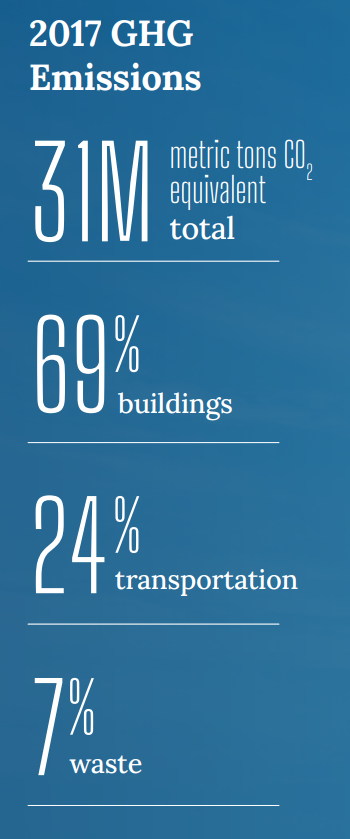Electrify Chicago
An independent tool for viewing City of Chicago building data
According to the
2022 Chicago Climate Action Plan,
69% of Chicago's emissions come from buildings, making
building emissions our biggest challenge and our biggest opportunity as a city
to tackle climate change. At Electrify Chicago, we showcase building performance using
publicly available data supplemented by community-submitted photographs and building
owners.
Start by looking at Chicago's buildings with the highest greenhouse gas intensity i.e. emissions per square foot. Large, efficient, buildings can perform much better than very inefficient small buildings on this metric.
New Article
📰 $30 Million In Missed Fines
The City Of Chicago failed to collect $30 million in potential fines from the building benchmarking ordinance, reducing transparency and accountability.
Legislative update! 🎉
As of late January 2024, legislation is being introduced to require new use more efficient forms of water and space heating, via the Clean And Affordable Buildings Ordinance (CABO), which will reduce the number of highly polluting and inefficient buildings that end up on this site.
If you're in Chicago,
write to your alderman to support the CABO!
Chicago Buildings by Greenhouse Gas Intensity
Note: Data includes large Chicago buildings with data from 2022, unless explicitly stated otherwise.
Note: This data only includes buildings whose emissions are reported
under the
Chicago Energy Benchmarking Ordinance. According to the City “As of 2016,
this list includes all commercial, institutional, and residential buildings larger than
50,000 square feet.” This dataset is also then filtered to only buildings with
reported emissions > 1,000 metric tons CO2 equivalent.
The latest year of data is from 2022, but we update the site regularly when new data is available, and some buildings may have failed to report that year, and only have older data available.
| Property Name / address | Primary Property Type |
Greenhouse Gas Intensity (kg CO2 eq./sqft) |
Total Greenhouse Emissions (metric tons CO2 eq.) |
|---|---|---|---|
|
Casa Queretaro
2012 W 17th St
| Multifamily Housing | 5.1 kg/sqft
Lowest 26%
| 270 tons
Lowest 6%
|
|
1740 N Maplewood
1740 N Maplewood
| Multifamily Housing | 5.1 kg/sqft
Lowest 26%
| 488 tons
Lowest 25%
|
|
Cuneo Hall-ID# 254160
🕰️
(Loyola)
6430 N Kenmore Ave
| Office | 5.1 kg/sqft | 272 tons |
|
Drexel Towers 4917
🕰️
4917 S Drexel Blvd
| Multifamily Housing | 5.1 kg/sqft | 366 tons |
|
7021 7035 N Sheridan Rd
7021 7035 N Sheridan Rd
| Multifamily Housing | 5.1 kg/sqft
Lowest 26%
| 408 tons
Lowest 17%
|
|
Winthrop Tower
6151 N Winthrop Ave
| Multifamily Housing | 5.1 kg/sqft
Lowest 26%
| 444 tons
Lowest 21%
|
|
Saucedo Elementary Academy - CPS
(CPS)
2850 W 24th Blvd
| K-12 School | 5.1 kg/sqft
Lowest 26%
| 1,502 tons
Highest 31%
|
|
Talcott Fine Arts And Museum Academy -CPS
🕰️
(CPS)
1840 W Ohio St
| K-12 School | 5.1 kg/sqft | 649 tons |
|
StClement_School
🕰️
642 W Deming Pl
| K-12 School | 5.1 kg/sqft | 383 tons |
|
StAlphonsus_School
🕰️
1439 W Wellington Ave
| K-12 School | 5.1 kg/sqft | 278 tons |
|
Bateman Elementary, Newton -CPS
(CPS)
4200 N Richmond St
| K-12 School | 5.1 kg/sqft
Lowest 26%
| 780 tons
Lowest 45%
|
|
Bradwell Arts & Sciences Elementary -CPS
(CPS)
7726 S Burnham
| K-12 School | 5.1 kg/sqft
Lowest 26%
| 727 tons
Lowest 42%
|
|
Manuel Perez Elementary -CPS
🕰️
(CPS)
1241 W 19th St
| K-12 School | 5.1 kg/sqft | 523 tons |
|
John Whistler Elementary -CPS
🕰️
(CPS)
11513 S Ada St
| K-12 School | 5.1 kg/sqft | 449 tons |
|
15th Place
811 - 833 W 15th Pl
| Multifamily Housing | 5.1 kg/sqft
Lowest 26%
| 1,294 tons
Highest 37%
|
Data Source:
Chicago Energy Benchmarking Data
